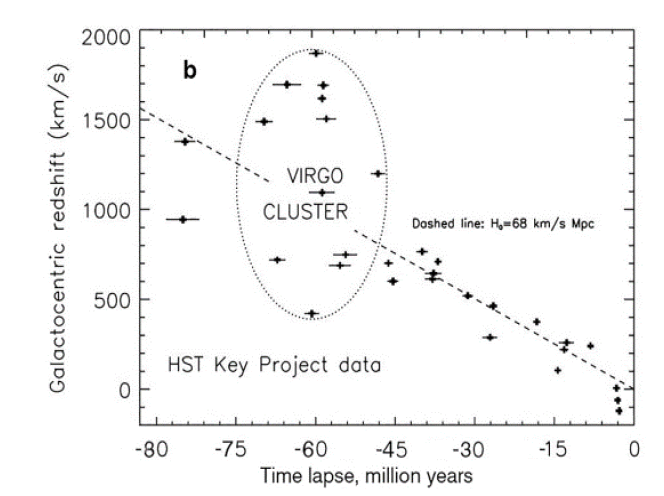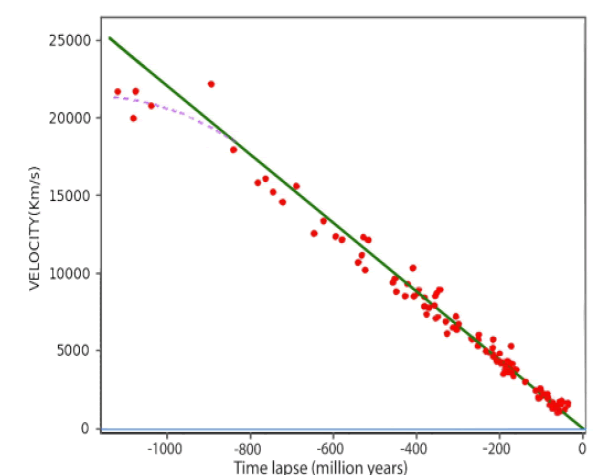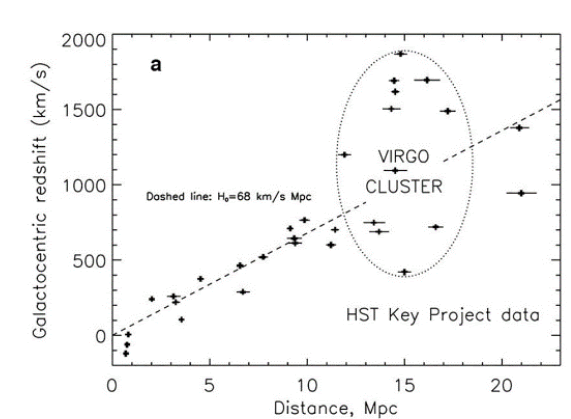Original Article
, Volume: 11( 6) DOI: 10.37532/2320-6756.2023.11(6).352Big Bang revisited
- *Correspondence:
- C.A. Kalfas National Centre for Scientific Research Demokritos, Institute of Nuclear & Particle Physics, 15310 Agia Paraskevi, Greece, E-mail: kalfas@spectr.gr
Received date: 02-June-2023, Manuscript No. tspa-23-101066; Editor assigned: 03-June-2023, Pre-QC No. tspa-23-101066 (PQ); Reviewed: 10-June-2023, QC No. tspa-23-101066 (Q); Revised: 13-June-2023, Manuscript No. tspa-23-101066 (R); Published: 15-June-2023, DOI. 10.37532/2320-6756.2023.11(6).352
Citation: Kalfas C.A. Big Bang Revisited. J. Phys. Astron.2023;11(6):352.
Abstract
An alternative interpretation of the data plotted in a Hubble-Lemaitre graph is presented. Also, an attempt is made to suggest a different origin of the cosmic background radiation.
Keywords
Expansion; CMBR
Introduction
During a talk for a March 1949 BBC Radio broadcast, the English astronomer Fred Hoyle, an advocate of the “steady state” cosmological model, coined ironically the term "Big Bang". However, the "Big Bang" is generally accepted as a valid theory attempting to describe the evolution of the Universe.
A distinction should be made between the observable Universe and the actual Universe. The former depicts a virtual reality since the obtained pieces of information are not concurrent. The latter is unattainable since no information can be transmitted instantaneously (disregarding quantum entanglement). The term “known Universe” is probably associated with the observable one.
Expansion of the Universe
The two pillars of the Big Bang cosmological model are the Hubble-Lemaitre law and the cosmic microwave radiation background. In comparing an ordinary explosion with the expansion of the universe, the error lies in comparing the kinematics of Newtonian mechanics (with an infinite speed of light) with those of a universe obeying the laws of relativity with a limited value of the speed of light. The red shift observations are not a snapshot of a universe as it is now but for each particular star (or galaxy) reveals how the expansion rate (redshift velocity) was at the time the light started its journey to the observer. The observed red shift for a galaxy, for example, 10 million light years away, is not as it is now but as it was 10 million years ago. We cannot know its value now by direct observation. We cannot even know if that particular star or galaxy still exists. Stars are born from the cosmic dust and eventually meet their final destiny, ranging from white dwarfs to supernova. Galaxies can merge and may even disappear in a black hole. As a result, the plot of the observed red shifts vs distance, the latter deduced from the cosmic ladder (Cepheid variables, parallax e.tc.) is misleading. As a general rule, a plot of various points which are not concurrent is meaningless unless the x axis is time. As a result, a more informative way is to plot the observed red shifts vs past time to which they actually belong.
It appears that the expansion rate (redshift velocity) was larger in the past (not to be confused with the proposed acceleration of expansion, as explained later) [1, 2]. The further a galaxy is away, the further to the past belongs the redshift information we record. There is no way we can have a snapshot of the universe at any instant. In other words, there is no way we can know how the Universe is now (or at any particular moment in general) as a result of the limited speed of light and this is an essential principle. No direct observation can give us a “picture” of the Universe at any particular moment. Theories and/or models can be proposed but in general any theory that is not verified with an experiment (direct observation) is of limited credibility. It took a measurement of the precession of the perihelion of Mercury to verify the validity of general relativity. Attempting to trace back or forth any redshift information requires the use of the Big Bang theory but this would be a typical example of trying to verify a theory based on its validity which of course is an oxymoron. The slope of the fitted line in FIG. 1 evaluated in kms-1million years-1, after including a more recent set of data, yielding a Hubble constant 73.40 ± 1.2 kms-1Mpc-1, gives a value of negative acceleration (deceleration) of the cosmic expansion 71.4 ± 1.2 × 10-14 kms-2 [3]. FIG. 2 (which is based on ref. [4], appropriately modified). It appears that the deceleration was constant at all times. The 3 points in FIG. 3 close to the origin with negative redshift (blue shift) belong to local galaxies (such as Andromeda). Their motion towards our galaxy is attributed to gravitational effects, rendering them of no value for the Hubble-Lemaitre law. However, in the light of the present work, this might not be so. Besides, there are almost 100 local galaxies with blue shifts.
Figure 1: The redshift-[past]time relation resulting from (a) when the distance in x-axis is replaced with the time when light started its journey to the observer (1 parsec~3.26 light years).
Figure 2: The redshift-[past] time relation based on data that include distant supernovae type Ia. The dashed line extension in the upper left corner is based on these supernovae.
More recent attempts to improve the cosmic distance ladder using distant type Ia supernovae do not actually affect the above reasoning. The observations related to these supernovae indicated that they were slightly too faint when compared to what was obtained from their intrinsic brightness. If so, they must be further away than estimated using the up to then cosmic ladder. As a result, it was proposed that the expansion of the Universe was slower in the past, compared to the estimated one for galaxies at closer distances [5]. The findings were interpreted as prove that the expansion is accelerated and Dark Energy was invoked to drive this acceleration but in fact, they confirm the proposed ideas in this work. If plotted correctly, the turning point of the fitted curve might indicate if and when the mode of expansion changed, from linear or even accelerated expansion to a slowing down. However, more data beyond 1.2 billion lightyears are needed and observations related to such distances are difficult to obtain. It should be noted that the term velocity used in this work is the redshift velocity since it is unambiguous for experimental observation, as opposed to recessional velocity. However, the arguments presented in this work are equally valid for both cases.
When the expansion rate is considered in this new perspective, the story revealed is entirely different from the one generally accepted. The expansion is slowing down. Furthermore, the intersect of the fitted line with the x axis indicates that the expansion reached (or is about to reach) a zero value. In other words, the first pillar of the Big Bang cosmological model, the redshift, must be reconsidered.
The second pillar, the Cosmic Microwave Radiation Background (CMBR) is interpreted with a-priori acceptance of the expansion of the universe. The reasoning is that if there were such an expansion, then these remands of the initial radiation would expand their wavelength accordingly. Thermal equilibrium would require that the current temperature would have dropped to the observed value of 2.7 K after the era of photon decoupling, assumed to be at a temperature of around 3000 K. The important question is what actually is meant by “current temperature”. Obviously, the photons of the cosmic background radiation originate-almost uniformly-in all parts of the universe and subsequently all times, due to the limitations of the speed of light. So, the meaning of “current” is an open question. The suggested surface of last scattering as a set of points in space at the “right” distance from us would have a meaning in a “static” universe but not in a continuous expanding one. What is more disturbing is that the Hubble constant deduced from the red shift does not agree with the one estimated from the CMBR using various methods and models, such as the ΛCDM model that assumes the validity of the BB theory (an initial much hotter and dense universe expanding ever since) [6]. A different method uses the temperature measurements based on the excitation of rotational levels of some interstellar molecules such as CO, linking them to the expansion rate through the relationship TCMB(z)=Tr×(1+z), where Tr is the “currently” measured MBR temperature value and z is the redshift [7]. The overall discrepancy is of the order of 6% to 8%, even considering the uncertainties in the measurements [H0=67.74±0.46 kms-1Mpc-1, as opposed to 73.4±1.2 kms-1Mpc-1, being one of the latest using an updated cosmic ladder [8, 3]. Baryon Acoustic Oscillation (BAO) measurements are in agreement with those of CMBR and the research for even smaller uncertainties is in progress [8].
One possible source for the observed CMBR, since the deceleration was constant in all times as proposed here, would be the Larmor radiation resulting from the deceleration of charged particles. However, this needs to be verified theoretically and in a set of laboratory measurements.
Inflationary Cosmology attempted to solve some of the disputed (or without plausible answers) questions arising in accepting the Big Bang theory but still has its limitations and is not generally accepted, although it can count for the homogeneity of the Universe [9]. One of the major problems in Inflationary Cosmology is the failure yet to observe CMBR polarization B-modes, although there is still research in progress.
Conclusions
In general relativity, Einstein had predicted the expansion of the Universe but naturally could not predict the current expansion status. If there were a Big Bang, then the Universe does not appear to be expanding increasingly but rather is slowing down at a constant deceleration, against the general belief for the opposite. Alternative explanations for the creation and its continuous inflation/de-inflation of the universe might shed some light in what the Cosmos can reveal. Various proposed ideas include the time dependence of various cosmological parameters, even the speed of light itself. For the moment what is certain is that the Universe is evolving and changing size. The proposed ideas in this work suggest that the Big Bang theory must be “revisited” and perhaps the Universe is older than the current estimation. If the latter is true then it will eliminate the need for an inflation theory. In addition, the so called “dark energy” (introduced to explain the “accelerated” rate of expansion) might find its place in the realm where “ether” (introduced to explain the propagation of light waves) now rests.
Acknowledgments
The author acknowledges that he received no funding in support for this research. The author also declares that he has no competing interests. All data needed to evaluate the conclusions in the paper are present here and/or in the cited references.
REFERENCES
- Keel WC. The road to galaxy formation. Berlin: Springer; 2007.
[Google Scholar] [Crossref]
- Freedman WL, Madore BF, Gibson BK, et al. Final results from the Hubble Space Telescope key project to measure the Hubble constant. Astrophys. J. 2001;553(1):47.
- Brout D, Scolnic D, Popovic B, et al. The pantheon+ analysis: cosmological constraints. Astrophys. J. 2022;938(2):110.
- The road to galaxy formation
- Riess AG, Strolger LG, Tonry J, et al. Type Ia supernova discoveries at z> 1 from the Hubble Space Telescope: Evidence for past deceleration and constraints on dark energy evolution. Astrophys. J. 2004;607(2):665.
- Aubourg É, Bailey S, Bautista JE, et al. Cosmological implications of baryon acoustic oscillation measurements. Phys. Rev. D. 2015;92(12):123516.
- Noterdaeme P, Petitjean P, Srianand R, et al. The evolution of the cosmic microwave background temperature-measurements of TCMB at high redshift from carbon monoxide excitation. Astron. Astrophys. 2011;526:L7.
- Plank Collaboration, Planck 2018 results I. Overview and the cosmological legacy of Planck, A&A. 641, A1, 1-56 (2020) [Google Scholar]
[Crossref]
- Earman J, Mosterin J. A critical look at inflationary cosmology. Philos. Sci. 1999;66(1):1-49.




